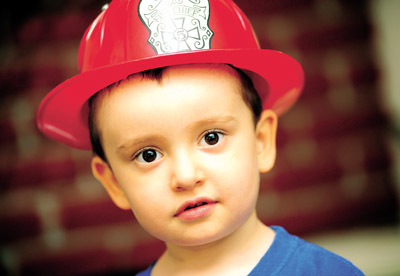
Ty Murray, 3, held his arms out like Buzz Lightyear from the
”
Toy Story
”
series as he did the character’s famous line,
”
To infinity and beyond.
”
He jumped on his dad’s back and giggled when his mom hugged him.
His dark eyes lit up as he handed plates of plastic food to guests
at his grandparents’ house on Line Street, where they watch him a
couple days a week while his parents work. Ty’s parents, though,
kept a close eye on the little boy who has been in and out of
hospitals since he was 16 months old. He was diagnosed with Stage 4
neuroblastoma.
Ty Murray, 3, held his arms out like Buzz Lightyear from the “Toy Story” series as he did the character’s famous line, “To infinity and beyond.” He jumped on his dad’s back and giggled when his mom hugged him. His dark eyes lit up as he handed plates of plastic food to guests at his grandparents’ house on Line Street, where they watch him a couple days a week while his parents work.
Ty’s parents, though, kept a close eye on the little boy who has been in and out of hospitals since he was 16 months old. He was diagnosed with Stage 4 neuroblastoma. The illness is a rare type of childhood cancer that is mostly diagnosed in toddlers. Around 650 children are diagnosed with neuroblastoma each year, according to the American Cancer Society.
“He’s thriving and running around,” said Carmen Hernandez Murray, Ty’s mother. “To look at him, you wouldn’t know he had cancer. He’s a normal 3-year-old who likes to play, but he is so used to the hospital.”
Ty’s doctors pronounced that there was no evidence of cancer in April, but his parents are still hopefully cautious.
“One of the other kids just relapsed after 20 months,” Carmen said. “We saw him two weeks before and he was fine. You couldn’t tell.”
Carmen mentioned another boy who went through the stem-cell transplant with Ty who had no evidence of the disease who died in July.
“We’ve met so many families. We know so many kids who have died,” she said. “We don’t want to read that we have no more options.”
Carmen and Scott Murray, Ty’s father, share the same story of how they were blindsided by his serious diagnosis.
“He had no symptoms, just low-grade fevers,” Carmen said. “He was fussy, but I was a new mom. I took him to the pediatrician and they said he is just colicky.”
Scott added that the doctors thought the fever was related to teething. He took his son to the doctor for the second time in a week when the little boy would only lay on his dad’s chest and didn’t want to play.
“The doctor did notice his stomach was distended,” Scott said.
The doctor sent the family for an x-ray and then to the emergency room because they thought he had an enlarged liver.
“Later on, they said he had a tumor, Wilms’,” Scott said. “They showed us it had a 90 percent survival rate, and that was devastating.”
With further testing, the doctors discovered Ty had neuroblastoma, a type of cancer of the sympathetic nervous system.
“Research tells you there is a 20- to 30-percent survival rate,” Scott said. “It turns your life upside down. The only important thing is to get him healthy.”
Carmen remembers vividly getting the news of her son’s diagnosis at Stanford Hospital.
“They said no, he has neuroblastoma. It’s a poor prognosis, stage 4,” she said. “I remember all these words and just saying neuroblastoma. It was heart breaking. You would never think cancer.”
Since the diagnosis, Ty has undergone an aggressive treatment plan. He has endured radiation, high-dose chemotherapy, a stem-cell transplant and is now part of a clinical trial at Memorial Sloan-Kettering Cancer Center in New York.
When he was first diagnosed he had a port put in with two plastic lines hanging out of his chest where doctors drew blood and administered his chemo treatments. Carmen and Scott found themselves overwhelmed with all the medical terms and procedures. Scott said despite Carmen’s bachelor’s and master’s degree, they would need a degree in biology to understand everything. They had to learn how to keep Ty’s port clean and to keep it from getting infected. Before every bath, they had to wrap it up in saran wrap. He now has a different port installed under the skin, so he can swim and bath without all the preparation.
The first year of treatment was especially hard.
See the full story in the Pinnacle on Friday.









